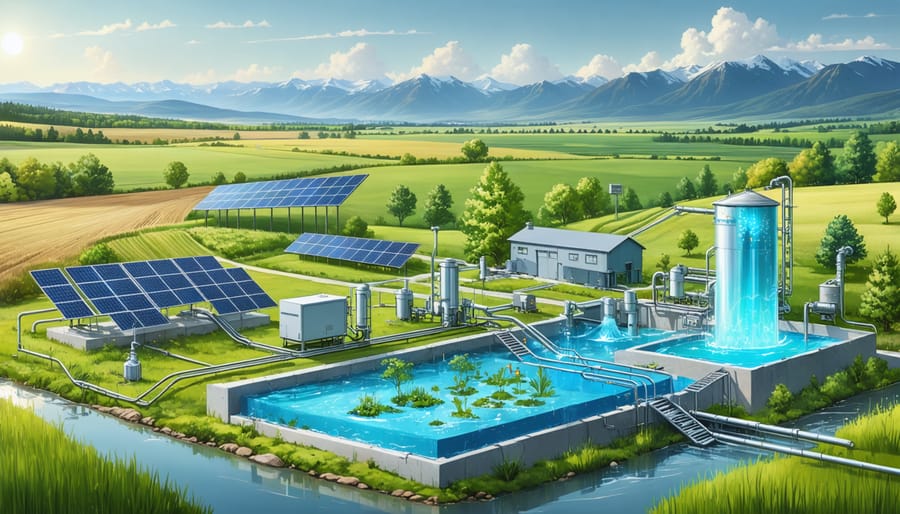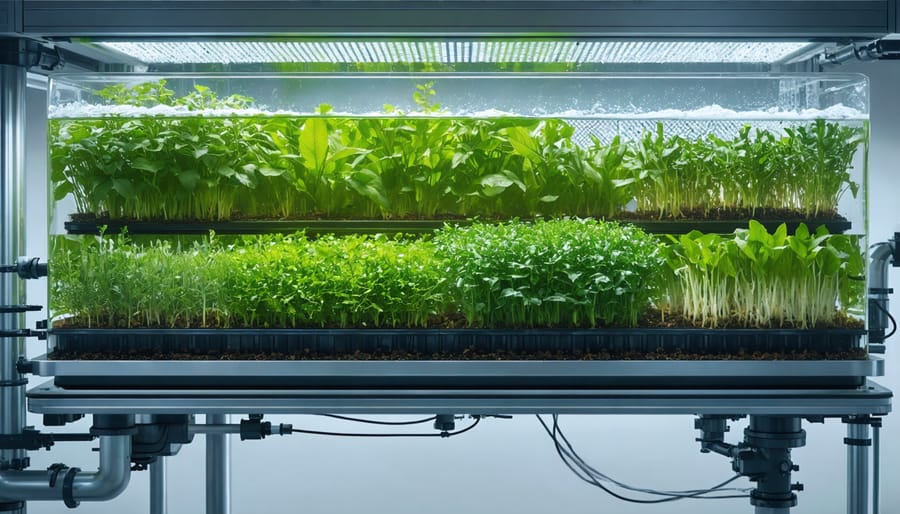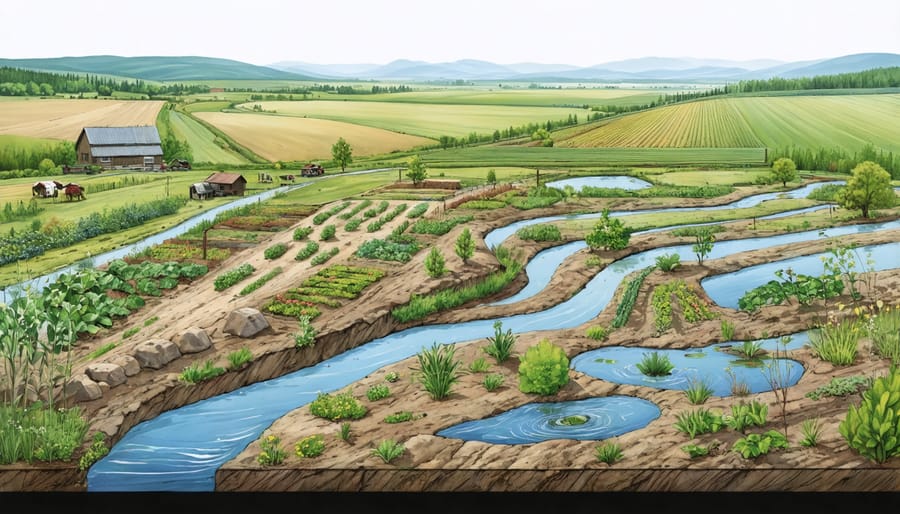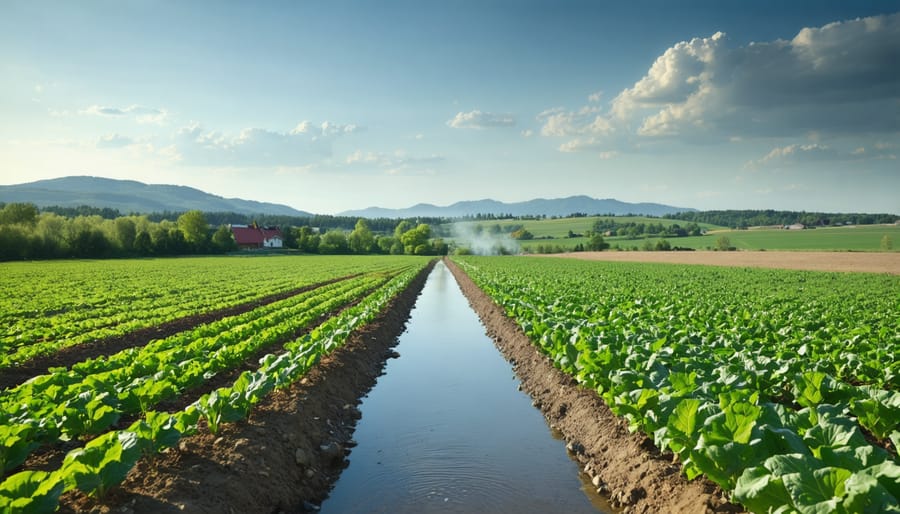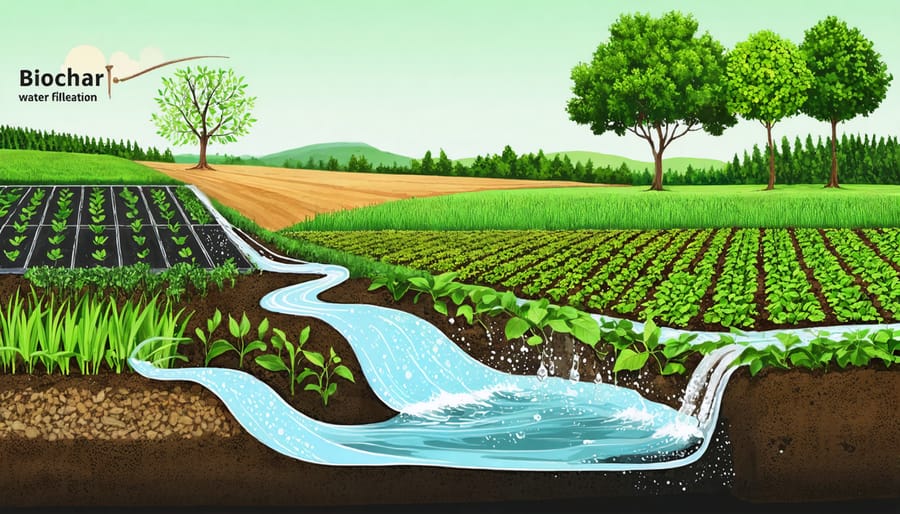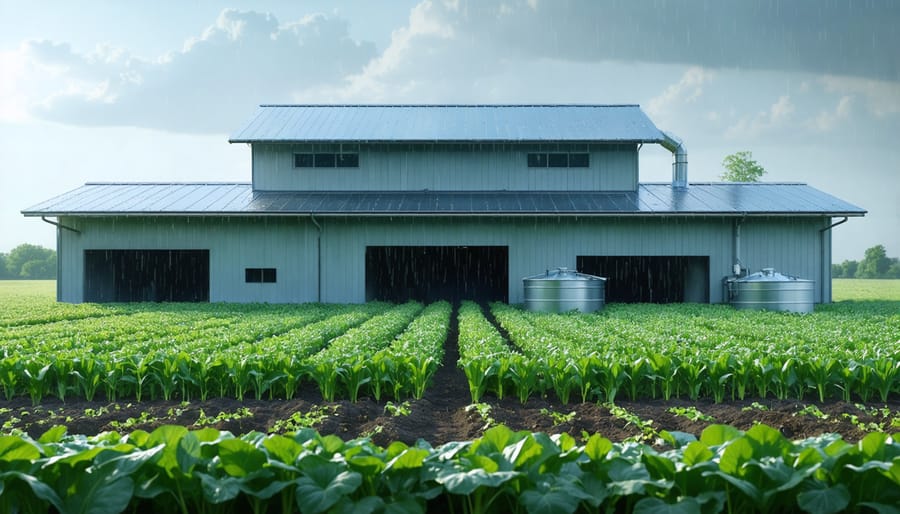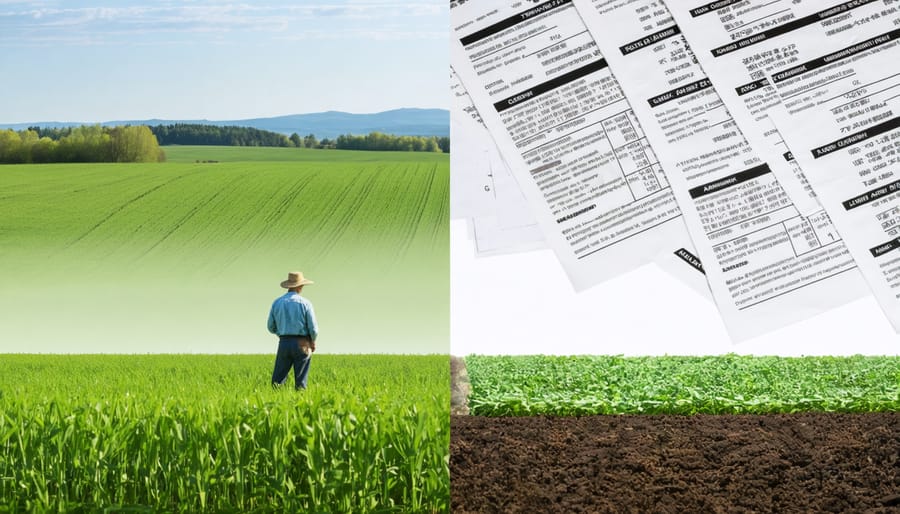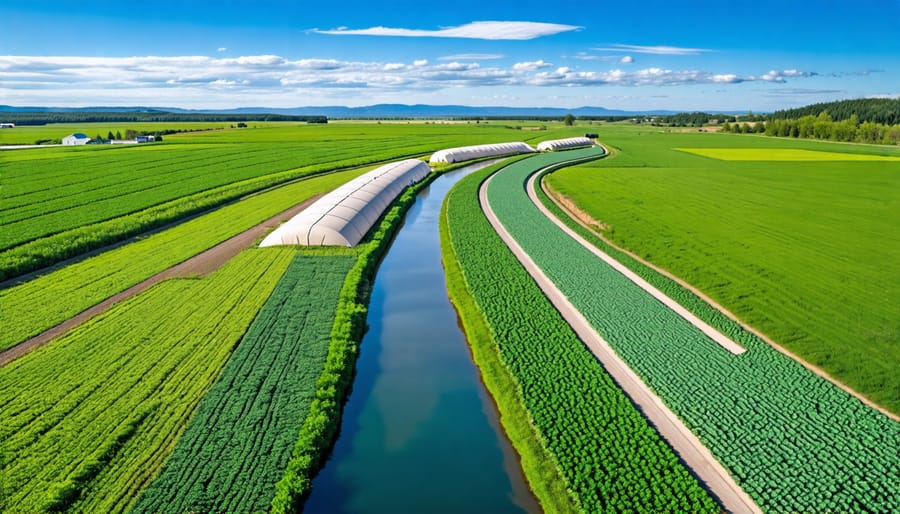Transform your farm’s water management with decentralized treatment systems that put control directly in your hands. Across Alberta’s diverse agricultural landscape, from Peace Country to Southern irrigation districts, farmers are revolutionizing their operations by treating water where it’s needed most – right at the source.
Decentralized water treatment empowers organic farmers to maintain strict certification standards while maximizing water efficiency. By processing water on-site through natural filtration, UV sterilization, and biological treatment methods, these systems eliminate the need for chemical additives while ensuring clean, safe water for crops and livestock.
The shift toward localized water treatment isn’t just about environmental stewardship – it’s about smart business. Alberta farmers implementing these systems report up to 40% reduction in water consumption and significant improvements in crop yields, particularly in water-stressed regions. With climate variability increasing, decentralized water treatment offers a practical, scalable solution that aligns with both organic farming principles and the bottom line.
Whether you’re managing a small-scale operation or a large organic enterprise, understanding decentralized water treatment options is no longer optional – it’s essential for future-proofing your farm while maintaining the highest standards of organic production.
Why Alberta Farms Need Decentralized Water Treatment
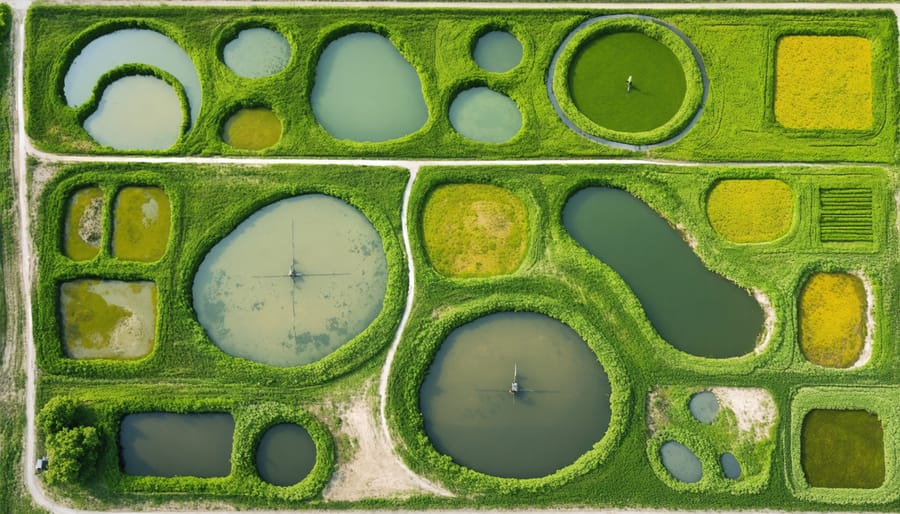
Local Water Quality Challenges
Alberta farmers face distinct challenges when it comes to water quality management, particularly in rural areas where municipal water systems aren’t available. Common issues include elevated levels of iron and manganese, which can affect irrigation systems and crop quality. Many wells in the province also show concerning levels of calcium and magnesium hardness, potentially impacting soil chemistry and equipment longevity.
Natural geological factors contribute to higher selenium concentrations in certain regions, while areas with intensive agricultural activity often experience increased nitrate levels in groundwater. Seasonal variations in water quality pose additional challenges, with spring runoff potentially introducing sediments and organic matter into water sources.
Recent monitoring data from Alberta Agriculture shows that approximately 25% of rural wells tested exceed at least one water quality parameter for agricultural use. This highlights the need for customized treatment solutions that address specific local conditions while maintaining compliance with organic certification requirements. Understanding these regional challenges is crucial for implementing effective decentralized treatment systems that ensure both crop safety and soil health.
Cost Benefits for Small-Scale Farms
For small-scale farms in Alberta, decentralized water treatment systems offer significant cost advantages over traditional centralized solutions. Initial installation costs typically range from $5,000 to $15,000, which is considerably less than connecting to municipal systems that can cost upwards of $50,000 for remote locations. Many farmers report recovering their investment within 3-5 years through reduced water hauling expenses and lower utility bills.
Local farmer Mike Thompson from Red Deer County shares, “Our decentralized system saves us roughly $4,000 annually in water delivery costs alone.” Beyond direct savings, these systems provide valuable operational flexibility, allowing farmers to treat water according to specific crop needs and adjust treatment intensity seasonally.
Government incentives further enhance the financial appeal. The Canadian Agricultural Partnership offers grants covering up to 30% of installation costs for qualifying farms implementing sustainable water solutions. Additionally, maintenance costs average just $500-800 annually, significantly less than the ongoing fees associated with municipal water services. The ability to scale treatment capacity gradually also helps farmers manage cash flow more effectively, making these systems particularly attractive for growing operations.
Decentralized Treatment Technologies for Organic Farms
Natural Filtration Systems
Embracing natural filtration systems offers Alberta farmers a sustainable approach to water treatment that works in harmony with the local environment. These systems harness natural processes to purify water while supporting biodiversity on your farm.
Constructed wetlands have proven particularly effective in our prairie climate, with several successful implementations near Lethbridge showing up to 90% reduction in agricultural runoff contaminants. These engineered ecosystems use native plants like cattails and bulrushes, which naturally filter water while providing habitat for beneficial wildlife.
Biofilters represent another practical solution, combining layers of organic materials like local river rock, sand, and native plant species to create a living filter. Many Red Deer area farmers have successfully integrated these systems, reporting improved water quality and reduced operational costs compared to conventional treatment methods.
For smaller operations, rain gardens and vegetated swales offer simple yet effective solutions. These systems can handle up to 25 millimetres of rainfall in a 24-hour period, making them ideal for managing seasonal precipitation patterns typical in central Alberta.
When designing your natural filtration system, consider working with local conservation authorities who can help identify the best native plant species and optimal placement based on your farm’s specific topography and soil conditions. Remember that these systems often qualify for environmental stewardship grants through Alberta’s Agricultural Service Board.
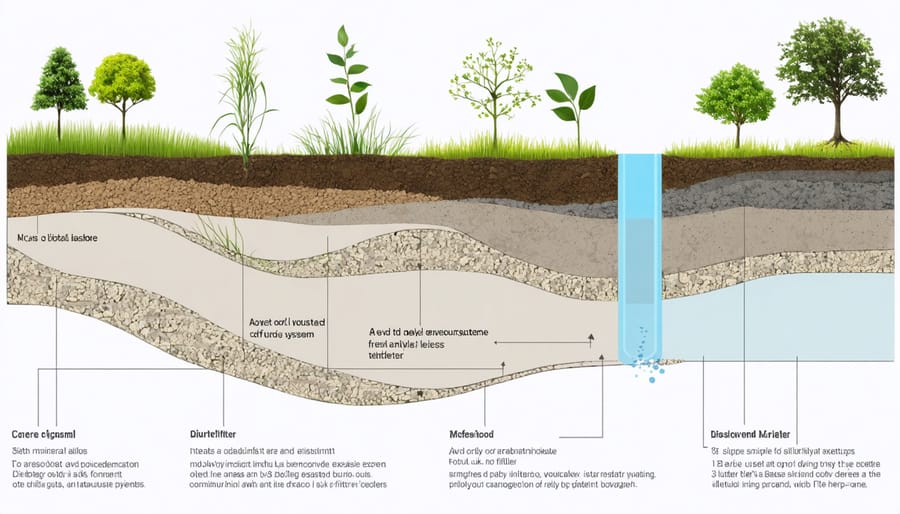
Greywater Recovery Systems
Greywater recovery presents a significant opportunity for Alberta farmers to reduce water consumption while maintaining productive operations. Modern water recovery systems can effectively process and reuse water from sinks, showers, and washing machines for agricultural purposes.
A typical farm greywater system consists of three main components: collection, filtration, and distribution. The collection phase involves directing used water from acceptable sources into a holding tank. This water then passes through a multi-stage filtration process, including settling tanks to remove solids, biological filters to break down organic matter, and UV treatment to eliminate harmful bacteria.
Many Alberta farmers have successfully implemented greywater systems for irrigation and livestock operations. For example, the Morrison Family Farm near Red Deer reports saving approximately 40,000 litres of water annually through their greywater recovery program. The treated water proves particularly valuable for greenhouse operations and non-food crop irrigation.
When designing a greywater system, consider factors like soil type, crop requirements, and seasonal variations. Local regulations require regular water quality testing and proper system maintenance. Most systems can be installed with minimal disruption to existing farm operations and typically pay for themselves within 3-5 years through reduced water costs and improved resource efficiency.
Remember to use only biodegradable, phosphate-free soaps and cleaning products to maintain system effectiveness and protect soil health.
Solar-Powered Treatment Options
In Alberta’s sun-rich climate, solar-powered water treatment systems offer an efficient and sustainable solution for farm water management. These systems typically combine solar panels with UV disinfection or reverse osmosis units, making them particularly effective during our long summer days when water demand peaks.
Local farmer Sarah Thompson from Red Deer County implemented a solar-powered treatment system on her 160-hectare farm in 2021. “The system powers itself through our sunny seasons, and the battery backup ensures continuous operation even during cloudy periods,” she explains. Her setup treats approximately 5,000 litres daily, sufficient for both livestock and crop irrigation needs.
These systems are especially valuable for remote locations where grid power isn’t readily available. Modern solar-powered units can effectively remove bacteria, parasites, and chemical contaminants while requiring minimal maintenance. Most systems include automated monitoring features that alert farmers to any issues via smartphone apps.
The initial investment typically ranges from $8,000 to $15,000, but government rebates through Alberta’s Environmental Farm Plan can offset up to 30% of the costs. When factoring in reduced energy bills and maintenance costs, most farmers report breaking even within 4-5 years.
For optimal performance in our climate, systems should be sized with winter operation in mind, typically requiring 20-30% more solar capacity than summer-only operations would need.
Real Farm Success Stories
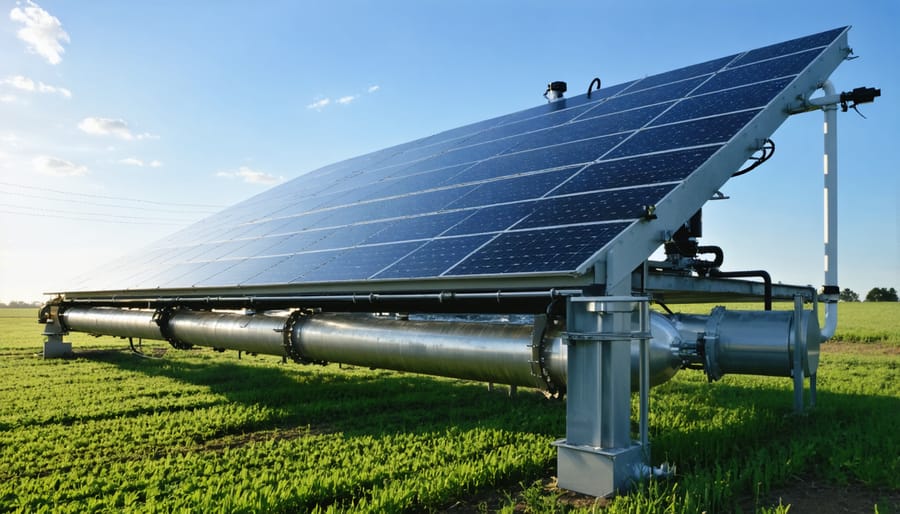
The Miller Family Farm Transformation
Located just outside of Olds, Alberta, the Miller Family Farm’s journey into decentralized water treatment began in 2019 when Sarah and James Miller faced increasing challenges with their irrigation system. Their 160-hectare organic vegetable operation required consistent, clean water to maintain organic certification and meet growing demand from local markets.
The Millers installed a three-stage treatment system, combining sand filtration, UV purification, and biological processing. The entire setup cost $75,000, with 40% covered by provincial agricultural grants. Within the first growing season, they noticed significant improvements in crop health and reduced their water consumption by 30%.
“The system practically pays for itself,” says Sarah Miller. “We’re using less water, our produce quality has improved, and we’ve cut our operational costs by about $12,000 annually.” The Millers now process 50,000 litres of water daily during peak season, all managed through a user-friendly control system that James monitors from his smartphone.
Their success has inspired neighbouring farms, with five other operations in the area implementing similar systems. The Millers regularly host farm tours and workshops, sharing their experience with other Alberta farmers. “It’s about building resilient farming communities,” James explains. “When one farm succeeds with sustainable practices, we all benefit.”
The Miller’s system has become a model for decentralized water treatment in organic farming, demonstrating how local solutions can create lasting impact.
Community Impact: Red Deer Valley Project
The Red Deer Valley Project stands as a shining example of how decentralized water treatment can transform rural communities. Since its implementation in 2019, this collaborative initiative has united 47 family farms across central Alberta, serving as a model for sustainable water management in agricultural regions.
The project emerged from a grassroots effort when local farmers faced increasing pressure on their water resources. Through partnership with the Alberta Watershed Alliance and local agricultural cooperatives, farmers established a network of small-scale treatment facilities strategically positioned throughout the valley.
Each facility serves 3-5 farms and processes approximately 50,000 litres of water daily, using a combination of biological filtration and UV treatment methods. The system’s design allows for seasonal adjustments, crucial during peak irrigation periods from June to August.
The results have been remarkable. Participating farms report a 40% reduction in water consumption and a 60% decrease in treatment-related energy costs. More importantly, the project has strengthened community bonds, with farmers sharing maintenance responsibilities and expertise.
Mary Thompson, a third-generation farmer in the region, notes, “This isn’t just about water treatment – it’s about building resilient communities. We’re making decisions together that benefit everyone while protecting our water resources for future generations.”
The project demonstrates how decentralized systems can effectively address rural water management challenges while fostering community collaboration and environmental stewardship.
Implementation Steps for Your Farm
Assessment and Planning
Before implementing a decentralized water treatment system, conducting a thorough assessment of your farm’s specific needs is crucial. Start by analyzing your current water sources, usage patterns, and quality requirements. Document your peak water demands during different seasons and consider future expansion plans.
Create a detailed map of your property highlighting water sources, potential treatment locations, and distribution points. This visual tool will help optimize system placement and identify potential challenges. Consider factors like elevation changes, power availability, and accessibility for maintenance.
Work with local agricultural extension services to conduct water quality tests and determine treatment requirements. Understanding parameters like pH levels, mineral content, and biological contaminants will guide your technology selection. This analysis should align with both organic certification requirements and your farm’s soil and water conservation practices.
Develop a budget that includes initial installation costs, ongoing maintenance, and potential energy requirements. Many Alberta farmers find success by starting with a smaller system and scaling up as needed. Consider connecting with neighbouring farms to share experiences and possibly resources.
Remember to factor in seasonal variations typical to Alberta’s climate, ensuring your chosen system can handle both summer irrigation demands and winter operations. Document your assessment findings to support funding applications and organic certification requirements.
Regulatory Compliance and Support
In Alberta, decentralized water treatment systems must comply with the Environmental Protection and Enhancement Act (EPEA) and the Water Act. Farmers implementing these systems should consult with their local county office and Alberta Environment and Parks to ensure their installations meet current standards.
The Agricultural Water Specialists Program offers free consultations to help farmers navigate regulatory requirements and identify suitable treatment solutions. Through the Canadian Agricultural Partnership (CAP), farmers can access funding of up to 30% of eligible costs for water treatment system installations that improve water quality and promote sustainable farming practices.
The Environmental Farm Plan (EFP) program provides additional support, offering workshops and one-on-one assistance to help farmers assess their water management practices and develop compliance strategies. Completing an EFP can also unlock access to additional funding streams and resources.
For organic producers, treatment systems must align with Canadian Organic Standards. The Organic Alberta association offers guidance specific to water treatment compliance in organic operations and can connect farmers with certified professionals familiar with organic requirements.
Local watershed stewardship groups across Alberta provide valuable resources and community support. These organizations often host educational events and can help farmers connect with others who have successfully implemented compliant water treatment systems. The Alberta Water Council also maintains up-to-date resources on regulatory changes and best practices for agricultural water management.
Decentralized water treatment offers Alberta farmers a powerful tool for sustainable agriculture, putting water quality control directly in your hands. By implementing these systems, you’re not just protecting your crops and livestock – you’re investing in your farm’s future while contributing to our province’s water conservation efforts. The benefits are clear: reduced operational costs, improved crop yields, and the satisfaction of knowing you’re farming responsibly. Whether you’re managing a small family farm or a large agricultural operation, there’s a decentralized solution that fits your needs. Take the first step today by assessing your water treatment needs and connecting with local agricultural extension services. Together, we can build a more sustainable farming future for Alberta, one farm at a time. Remember, every drop of properly treated water contributes to healthier soil, better yields, and a stronger agricultural community.

